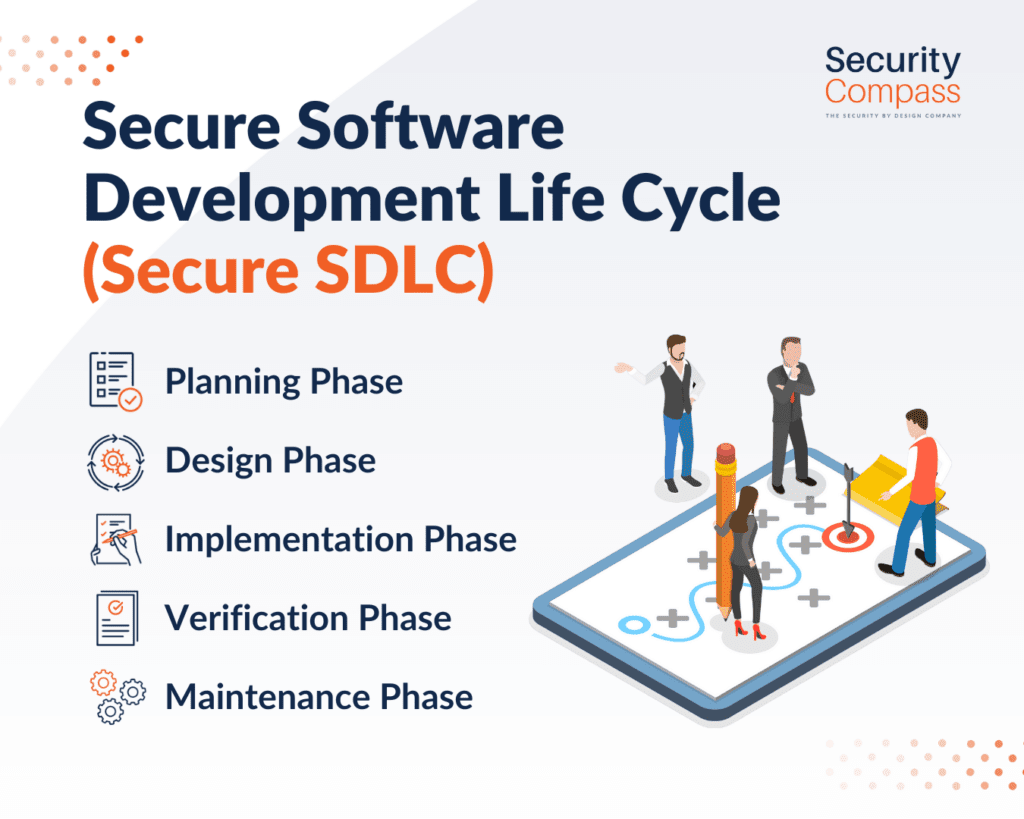Secure software development is crucial for any organization that aims to deliver high-quality products and applications. With attack vectors becoming increasingly prevalent, creating secure development practices within teams is more critical than ever. With pressures to deliver products and applications quickly, security often seems at odds with development velocity. Security is seen as a bottleneck that can be deferred until after the product launches to market. For security to become a priority, a security-by-design mindset is necessary, which is the core focus of today’s blog post.
Secure Software Development Life Cycle (Secure SDLC)
Secure Development is centered around the Secure Software Development Life Cycle (Secure SDLC), which is a sequence of phases that software goes through during development. The five main phases are Planning, Design, Implementation, Verification and Maintenance. By incorporating security practices into every phase of the Secure SDLC, organizations can significantly reduce the security risks associated with the software they launch into the market. Instead of a bolt-on, where security issues are discovered in production during maintenance or in staging during verification, it’s imperative that organizations shift left by incorporating security-by-design in earlier phases. By avoiding reengineering and rework, security issues are significantly cheaper to mitigate earlier in the Secure SDLC. SD Elements will help you introduce security by design to each phase of the Secure SDLC.
Planning Phase: Setting Security Goals & Objectives
Planning commences the Secure SDLC, where key stakeholders define the security requirements using relevant security policies. Security goals and objectives must be clearly captured through security requirements, which must also align with the organization’s overall security goals and objectives. Stakeholders must clearly articulate, ‘What are we working on?’, during the planning phase. SD Elements empowers stakeholders to answer survey questions to capture and communicate decisions from the Planning phase. SD Elements also identifies relevant security activities and security requirements that should be completed during the Planning phase. Using SD Elements during the Planning phase allows organizations to plan the secure-by-design products that customers can unbox in the near future.
Design Phase: Identifying Security Controls & Architecting the Product
During the Design phase, security controls and architectural components are identified to ensure security requirements identified in the Planning phase will be met during the upcoming Implementation phase. Threats, weaknesses, and risks lurk behind every decision made during the Design phase, forcing stakeholders to consider ‘What can go wrong?’ with their design. Enumerating threats is not enough; stakeholders must also architect & design mitigations, referred to as countermeasures. This can be done manually, one threat at a time, or it could be automated using SD Elements. SD Elements uses the survey completed during the Planning phase to identify threats and weaknesses and allows stakeholders to visualize their design using diagrams. By incorporating these security controls and architecture decisions seamlessly into the product, the product will be secure by design from the onset. Customers prefer to unbox a secure-by-design product over a product that bolts on security prior to launch.
Implementation Phase: Writing Secure Code, Static Analysis & SCA
In the Implementation phase, software developers write secure code using the security requirements in the Planning phase and the security controls & architectural components added in the Design phase. Within a Secure SDLC, developers consider ‘What are we going to do about it?’ by implementing relevant countermeasures. Developers also use best practices to avoid introducing common security issues. Static Analysis (SAST) and Software Composition Analysis (SCA) help developers identify and mitigate security issues during the Implementation phase. These are often three separate activities in the Implementation phase. A Secure SDLC using SD Elements can use SAST and SCA information to mark countermeasures as complete, allowing developers to focus on countermeasures that need their attention. SD Elements also provides helpful code snippets, configuration guidance, and Just-in-Time Training to give developers clear, concise, and actionable guidance during the Implementation phase. Lastly, using SD Elements allows relevant countermeasures to be synchronized with JIRA, GitHub, GitLab, Azure DevOps, and other issue trackers, allowing developers to complete the Implementation phase using a familiar tool. Securely completing the Implementation phase is crucial to shipping a secure-by-design product.
Verification Phase: Performing Code Reviews & Dynamic Analysis
Very close to launch, the Verification phase validates that security requirements are implemented correctly without inadvertently introducing additional security issues. Developers work closely with security teams to verify, ‘Did we do a good enough job’ within the Verification phase of the Secure SDLC. Manual code reviews, automated test cases, and Dynamic Analysis (DAST) help teams verify security controls were introduced properly. SD Elements provides testing countermeasures to help security teams manually verify the implementation of countermeasures. DAST scan information can be integrated with SD Elements to resurface any countermeasures that require additional attention from developers. To ship a secure-by-design product, secure-by-default configurations must be verified through the Verification phase.
Maintenance Phase: Security Monitoring & Patching
Moving onto our final phase, the Maintenance phase, where teams regularly review and update security controls to mitigate new and emerging security issues. Security patches may be required to mitigate certain security issues. In the Secure SDLC, security is continuously monitored, allowing teams to promptly respond when necessary. Subsequent releases or feature enhancements will prompt the team to step through each step of the Secure SDLC again. Software exiting the Maintenance phase will require proper decommissioning, including the secure disposal or archival of data. Using SD Elements, new and emerging security issues identified during the Maintenance phase can be shared with other development teams so they can introduce relevant security controls in earlier phases of their Secure SDLCs.
With me so far?
By introducing security into each phase of the SDLC to create a Secure SDLC, instead of leaving security to be an afterthought, organizations can minimize the security risks associated with their software. A Secure SDLC helps create a culture of security within development teams. SD Elements helps with each phase of the Secure SDLC, allowing organizations to introduce Security by Design at scale across their entire portfolio.
Discover the impact of SD Elements on Secure Development. Ready to explore how SD Elements can transform your Secure SDLC? Reach out to us now. Or, if you’re eager to experience Security by Design with SD Elements, view our instant product tour.

